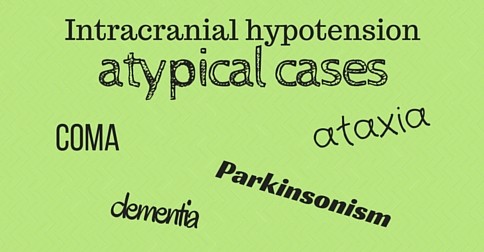This recent paper highlights that the clinical presentation of spontaneous intracranial hypotension secondary to spinal cerebrospinal fluid leak may include serious patterns considered atypical. The authors compared the clinical and imaging findings of 8 atypical cases with 33 classic cases.
When a patient presents with coma or signs and symptoms consistent with Parkinsonism, dementia or ataxia, spontaneous intracranial hypotension is not often considered as a cause. Greater awareness is needed.
Atypical Presentations of Intracranial Hypotension: Comparison with Classic Spontaneous Intracranial Hypotension
Capizzano AA, Lai L, Kim J, Rizzo M, Gray L, Smoot MK, Moritani T.
AJNR Am J Neuroradiol. 2016 Mar 3. [Epub ahead of print]
Abstract
BACKGROUND AND PURPOSE:
Atypical clinical presentations of spontaneous intracranial hypotension include obtundation, memory deficits, dementia with frontotemporal features, parkinsonism, and ataxia. The purpose of this study was to compare clinical and imaging features of spontaneous intracranial hypotension with typical-versus-atypical presentations.
MATERIALS AND METHODS:
Clinical records and neuroimaging of patients with spontaneous intracranial hypotension from September 2005 to August 2014 were retrospectively evaluated. Patients with classic spontaneous intracranial hypotension (n = 33; mean age, 41.7 ± 14.3 years) were compared with those with intracranial hypotension with atypical clinical presentation (n = 8; mean age, 55.9 ± 14.1 years) and 36 controls (mean age, 41.4 ± 11.2 years).
RESULTS:
Patients with atypical spontaneous intracranial hypotension were older than those with classic spontaneous intracranial hypotension (55.9 ± 14.1 years versus 41.7 ± 14.3 years; P = .018). Symptom duration was shorter in classic compared with atypical spontaneous intracranial hypotension (3.78 ± 7.18 months versus 21.93 ± 18.43 months; P = .015). There was no significant difference in dural enhancement, subdural hematomas, or cerebellar tonsil herniation. Patients with atypical spontaneous intracranial hypotension had significantly more elongated anteroposterior midbrain diameter compared with those with classic spontaneous intracranial hypotension (33.6 ± 2.9 mm versus 27.3 ± 2.9 mm; P < .001) and shortened pontomammillary distance (2.8 ± 1 mm versus 5.15 ± 1.5 mm; P < .001). Patients with atypical spontaneous intracranial hypotension were less likely to become symptom-free, regardless of treatment, compared with those with classic spontaneous intracranial hypotension (χ2 = 13.99, P < .001).
CONCLUSIONS:
In this sample of 8 patients, atypical spontaneous intracranial hypotension was a more chronic syndrome compared with classic spontaneous intracranial hypotension, with more severe brain sagging, lower rates of clinical response, and frequent relapses. Awareness of atypical presentations of spontaneous intracranial hypotension is paramount.
PMID: 26939631


